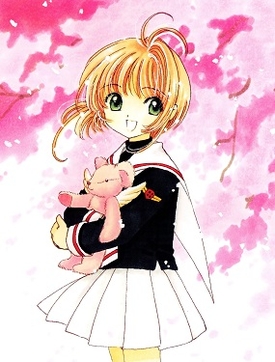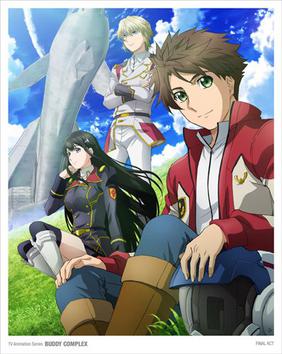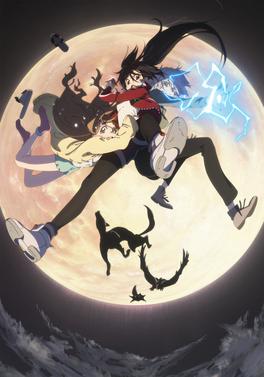
Please Twins! is an anime television series scripted by Yōsuke Kuroda and produced by Bandai Visual, which was later adapted into a light novel and one-volume manga series. It centers on a family of three teenagers in high school all living together who are unsure which two of them are related to each other due to a reference from an old photograph. The Please Twins! anime series is a spin-off sequel to Please Teacher!. It first aired in Japan on the WOWOW satellite television network on July 15, 2003 and finished with a total of 12 episodes plus a later OVA episode released on DVD. The series was later adapted into a light novel in 2004, which spanned a total of two volumes and, soon after, into a short one-tankōbon manga version, which was serialized in MediaWorks's Dengeki Daioh magazine in September 2005.

I"s is a Japanese manga series written and illustrated by Masakazu Katsura. It follows Ichitaka Seto, a high school student who is in love with his classmate Iori Yoshizuki, but is too shy to tell her. Again and again he plans to tell her his true feelings, but each time something gets in the way. Things become even more complicated when Itsuki Akiba returns to Japan; she is a girl Ichitaka was friends with in their childhood before she moved to the United States, and who had a huge crush on him.

Ojamajo Doremi, alternatively titled Magical DoReMi in English, is a Japanese fantasy magical girl anime television series created by Toei Animation. It focuses on a group of elementary school girls, led by Doremi Harukaze, who become witch apprentices. The series aired in Japan on ABC, TV Asahi and other ANN affiliates between February 1999 and January 2003, spanning four seasons and 201 episodes, and was followed by an original video animation series released between June and December 2004. An English-language version of the first season, produced by 4Kids Entertainment, aired in North America in 2005.

Lamune is a Japanese adult visual novel developed by Neko Neko Soft. Originally released on July 30, 2004, for the PC. It was followed by an all-ages version for the PlayStation 2, and was released on August 25, 2005. A twelve-episode anime series based on the visual novel, entitled Lamune: Garasu Bin ni Utsuru Umi, was produced by Trinet Entertainment and Picture Magic and aired between October 11, 2005, and December 27, 2005. Light novels, drama CDs, and one volume of a manga adaption have also been produced.

Tomoyo After: It's a Wonderful Life is a Japanese adult visual novel developed by Key released on November 25, 2005 for Windows PCs. The game is a spin-off of Key's earlier all ages game Clannad. Key later released versions of Tomoyo After without the erotic content, and the game was ported to the PlayStation 2, PlayStation Portable, Xbox 360, PlayStation 3 and Nintendo Switch under the title Tomoyo After: It's a Wonderful Life CS Edition; CS stands for "consumer software". The story follows the lives of Tomoya Okazaki, a young man who recently graduated from high school, and his close friend Tomoyo Sakagami as they start to see more of each other in a romantic relationship.

Happiness! is a Japanese adult visual novel developed by Windmill released on October 21, 2005 for Windows PCs. The game was later ported to the PlayStation 2. An adult fan disc titled Happiness! Re:Lucks was developed by Windmill's sister brand Windmill Oasis and released on July 28, 2006 for Windows. A manga illustrated by Rino Fujii was serialized in Media Factory's Monthly Comic Alive between 2006 and 2007. A series of novels were published by Harvest between 2006 and 2008. A 12-episode anime produced by Artland aired in Japan between October and December 2006, and an original video animation episode followed in January 2007.

True Tears is a Japanese visual novel developed by La'cryma, a collaboration between Broccoli, Circus, GameCrab and Rei Izumi, and was originally released on March 31, 2006 for the Windows as a DVD in Japan rated for everyone, followed by a Hong Kong and Taiwanese release on March 31, 2007. A PlayStation 2 version was first announced to be released on March 13, 2008, but was later delayed for an August 7, 2008 release. The gameplay in True Tears follows a linear plot line, which offers pre-determined scenarios and courses of interaction, and focuses on the appeal of the five female main characters.

Sola is a Japanese work originally conceived by Naoki Hisaya with original character design by Naru Nanao. It was first unveiled through the prologue of the manga featured in the Japanese manga magazine Dengeki Daioh on December 21, 2006, published by MediaWorks. The manga, which is illustrated by Chako Abeno, ended serialization on February 21, 2008. The manga has been licensed for distribution in North America by Broccoli Books with the first volume being released in June 2008. A short drama CD which also served as a prologue to the series was released at Comiket 71 in December 2006, and a second drama CD was released in May 2008. An anime version aired in Japan between April and June 2007; the anime contained thirteen episodes, and two additional DVD-exclusive episodes followed. The anime was licensed by Bandai Entertainment for distribution in North America in a subtitle-only box set of all fifteen episodes. The title, Sola, is close in pronunciation to the Japanese word sora. At the end of 2007, Japanese anime fans voted Sola as the best anime of the year.

KimiKiss is a Japanese dating simulation game for the PlayStation 2. Developed by Enterbrain in 2006, KimiKiss has become a media franchise, which includes five manga adaptations, a light novel, and an anime television series directed by Ken'ichi Kasai.

Shigofumi: Letters from the Departed, titled Shigofumi: Stories of Last Letter in Japan, or simply Shigofumi, is a Japanese anime television series created by Tomorō Yuzawa and produced by Bandai Visual and Genco, which aired in Japan on Chiba TV and other networks between January 6 and March 22, 2008, and contains twelve episodes. An original video animation episodes was included with the final anime DVD volume released on September 26, 2008. A light novel series was originally adapted from the anime's premise set by Tomorō Yuzawa, featuring story composition and illustrations by Ryō Amamiya and Poko, respectively. Four novels were published by MediaWorks under their Dengeki Bunko imprint between October 2006 and March 2008. Despite the novels being produced first, the anime is considered the original work, as stated by Yuzawa. The anime was acquired by Bandai Visual for English language localization. The title Shigofumi comes from the combination of the Japanese words for "after death", and "letter", which literally translates to an "after death letter". However, the release was cancelled and Bandai Visual closed its North American branch. Sentai Filmworks picked up the license and released the entire series on DVD in 2010.

MM! is a Japanese light novel series by Akinari Matsuno, with illustrations provided by the group QP:flapper made up of Tometa Ohara and Koharu Sakura. Media Factory published 12 novels under their MF Bunko J imprint between February 2007 and September 2010, including two side story volumes. The series was left unfinished due to the author's death on April 18, 2011. A manga adaptation by Issei Hyoju was serialized between the September 2008 and February 2012 issues of Media Factory's Monthly Comic Alive. A drama CD adaption was released by Edge Records on March 24, 2010 and its first-press limited edition came with a bonus CD. A 12-episode anime adaptation produced by Xebec aired between October and December 2010. Sentai Filmworks released the anime series on English-subtitled DVD in North America in September 2011, and then re-released it in February 2014 with an English dub on both DVD and Blu-ray.

Sakura Kinomoto is the main protagonist and title character of Clamp's manga series Cardcaptor Sakura. In the English anime adaptation by Nelvana of the series, Cardcaptors, she is known as Sakura Avalon, though her surname was changed back in the second film's dub by Bang Zoom! Entertainment.

Buddy Complex is a Japanese mecha anime television series produced by Sunrise. The series aired between January 5, 2014 and March 30, 2014. The first episode was pre-aired on December 29, 2013. A manga adaptation began serialization in ASCII Media Works' Dengeki Daioh from January 27, 2014. A 2-part sequel aired on September 29 and 30, 2014.

Revisions is an anime television series directed by Gorō Taniguchi and animated by Shirogumi. The series aired from January to March 2019 on Fuji TV's +Ultra programming block.

Blackfox is a Japanese anime film produced by studio 3Hz. It premiered in Japan on October 5, 2019.
Maryuu Senki, also known as Evil Dragon War Chronicles, is a Japanese OVA series which combines elements from Japanese folklore with dark fantasy. Produced by Bandai Visual and animated by AIC, it was released between 1987 and 1989 for three episodes. It was adapted into an unfinished manga series in 1991.

Vanitas is the fictional protagonist and title character of the manga series The Case Study of Vanitas, which was written and illustrated by Jun Mochizuki. The character was named Vanitas of the Blue Moon, making him part of the Blue Moon clan with some vampire abilities. Vanitas possesses a grimoire called The Book of Vanitas, which can restore vampires who have become "curse-bearers" with uncontrolled bloodlust due to the corruption of their names. He enlists the vampire Noé Archiviste in his quest.

















